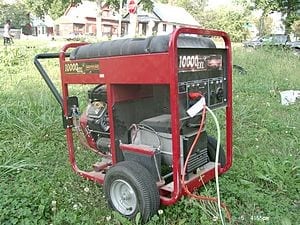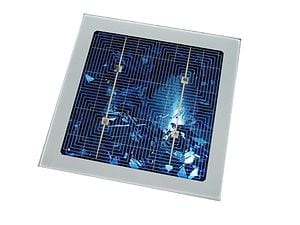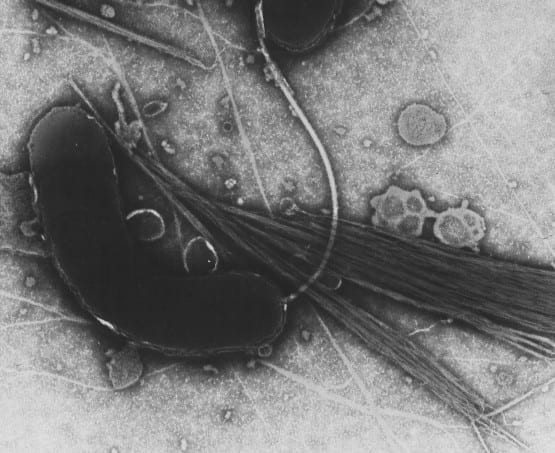
Compared with standard portable generators, CO emissions from the prototype machines were reduced by 90 percent or more
Portable electric generators retrofitted with off-the-shelf hardware by the University of Alabama (UA) emitted significantly lower levels of carbon monoxide (CO) exhaust, according to the results* of tests conducted by the National Institute of Standards and Technology (NIST) for the U.S. Consumer Product Safety Commission (CPSC).
Compared with standard portable generators, CO emissions from the prototype machines were reduced by 90 percent or more, depending on the specific hardware used and operating conditions.
According to the Centers for Disease Control (CDC), unintentional CO poisoning claims more than 400 lives a year. More than 20,000 people visit the emergency room and more than 4,000 are hospitalized due to exposure to toxic levels of the colorless, odorless gas. Fatality is highest among people 65 and older.
Many of these deaths and illnesses stem from unsafe use of portable generators, often in the aftermath of devastating storms and other causes of electric power outages. For the years 2005 to 2008, the CPSC reports that an estimated 37 to 47 percent of non-fire-related consumer product-related CO poisoning deaths were associated with generators.
The tests performed by NIST compared two commercially available gasoline-powered generators against two similar machines that UA retrofitted with closed-loop electronic fuel injection and a small catalyst. Tests were conducted at NIST’s manufactured test home, with the generator operating in the attached garage so as to simulate some common scenarios that often result in deaths or injuries.
In one series of comparisons, generators operated three or more hours in the garage with the garage bay door open and the entry to the house closed. For the stock generator tested, CO levels in the garage peaked at 1,500 parts per million (ppm,which are equivalent to microliters per liter) and inside the house ranged between 150 and 200 ppm.
Clinical symptoms of CO poisoning, including headaches, nausea, and disordered thinking, begin appearing at exposure levels of 100 ppm after at least 90 minutes exposure. During the NIST tests, emissions from the prototype generators ranged from 20 to 30 ppm in the open garage and from 5 to 10 ppm in the house.
CPSC staff conducted health effects modeling using NIST’s test results, as part of CPSC’s technology demonstration program of the prototype generator, to show that its engine’s reduced CO emission rate is expected to result in fewer deaths by significantly delaying the onset and rate of progression of CO poisoning symptoms compared to the stock generator.
On the basis of results of findings from NIST’s two earlier studies,** the CDC advises to never run a generator less than 20 feet from an open window, door, or vent where exhaust can vent into an enclosed area. Steven Emmerich, the lead NIST researcher, reminds that generators should always be operated outdoors, far from open windows. “Tragically, fatalities and injuries occur every year,” he says. “We hope our research in support of CPSC’s efforts to develop and demonstrate a low CO emission generator using existing emission control technology will contribute to practical safety improvements that will help to reduce this toll.”
The Latest Bing News on:
Portable electric generators
- Atlas Copco Offers Portable Nitrogen Membrane Generatorson April 23, 2024 at 7:40 am
The NM 500-25 and NM 1000-25 are designed for small-scale applications with a lower need for nitrogen, while the NM 2000-25 and NM 3000-25 meet the demands of large, intensive projects.
- Save up to $1,200 on a Jackery generator with these huge Earth Day dealson April 22, 2024 at 10:33 am
Whether you're looking for a lot of power or a little, you can save a bundle on a Jackery power solution thanks to this "Earth Day Extravanganza" sale.
- Our Favorite Portable Generators Are up to 43% off This Weekendon April 21, 2024 at 9:13 am
You can save up to 43 percent on portable generators and power stations, allowing you to power camping trips, tailgate parties, and weekend barbecues without breaking the bank. Generators are ...
- portable poweron April 19, 2024 at 4:59 pm
But what happens when there is no handy mains supply to recharge it from? Step in [Chleba], with a hand cranked generator. There are plenty of hand cranked generators to be found online ...
- Choose Between These 7 Types Of Generators For Your Homeon April 18, 2024 at 7:29 am
While smaller in generator size, a portable generator has a long list of uses. Fueled by gasoline, solar power or propane, these types of generators will cost less than a whole house generator.
- The Best Portable Power Stations of 2024, Tested and Reviewedon April 17, 2024 at 1:30 pm
I’ve been testing portable power stations for years as part of my ongoing test of the best solar generators. In that time I’ve noted the features that matter most for home emergencies and off-grid ...
- Harbor Freight's 4375W Vs. Honda's EG4000 Generator: What's The Difference?on April 17, 2024 at 1:15 pm
There are many reasons to own a generator, whether to power your home in an emergency or help on a job site. The question is which one is worth your money.
- Disaster Preparedness: How to Maintain Your Generatoron April 16, 2024 at 11:54 am
For gas Generators: Use ethanol-free gas treated with fuel stabilizer, and keep the tank full when not in use. Also keep a gas can full of stabilized fuel on hand during you peak disaster season. For ...
- Reliable Power Outdoors? Choose Westinghouse 4650 Peak Watt Dual Fuel Portable Generator, 41% Offon April 16, 2024 at 7:37 am
The Westinghouse Outdoor Power Equipment 4650 Peak Watt Dual Fuel Portable Generator, now available with an 41% discount on Walmart.
- This Power Station Offers an Impressive (but Expensive) Way to Keep the Power on During an Outageon April 15, 2024 at 11:48 am
After an unusual ice storm knocked out power at my house for days this year, I found myself feeling weirdly vulnerable without a way to heat my home, so I decided to look into power backup options. To ...
The Latest Google Headlines on:
Portable electric generators
[google_news title=”” keyword=”Portable electric generators” num_posts=”10″ blurb_length=”0″ show_thumb=”left”] [/vc_column_text]The Latest Bing News on:
CO emissions reduction
- CT greenhouse gas emissions up as climate change bills languishon April 27, 2024 at 3:05 am
As climate change bills struggle to get through the current legislative session, a new report shows Connecticut transportation emissions have increased sharply since 2020.
- Sustainability in the supply chain: More emissions-reporting challenges ahead?on April 26, 2024 at 3:39 pm
Transportation companies face new carbon-reporting mandates as well as increased scrutiny from investors, shippers, and consumers concerned about their eco-impact. What’s a transportation provider to ...
- CT not on track to meet 2030 climate goals as vehicle emissions remain high, report sayson April 26, 2024 at 2:51 pm
Greenhouse gas emissions in Connecticut keep going up, with vehicles still the top emitter having not decreased significantly from 1990 levels.
- Building owners sue Colorado, Denver over new green-energy rules that would force move away from natural gason April 26, 2024 at 4:18 am
The lawsuit names as defendants the Colorado Department of Public Health and Environment and its executive director, the Colorado Energy Office and its executive director and the Denver Office of ...
- Nestlé Vietnam promotes initiatives on emission reductionon April 26, 2024 at 3:25 am
Nestlé Vietnam has held a workshop to discuss initiatives to help slash emissions across the supply chain sector.
- CU Boulder releases plan to achieve zero emissions by 2050on April 25, 2024 at 10:19 pm
The University of Colorado Boulder released a plan on Thursday outlining steps to achieve a 50% reduction in campus emissions by 2030 and a reduction to zero emissions no later than 2050.
- Scientists say voluntary corporate emissions targets not enough to create real climate actionon April 25, 2024 at 11:00 am
Companies' emissions reduction targets should not be the sole measure of corporate climate ambition, according to a new perspective paper.
- Colorado and Denver sued for allegedly violating federal laws on large-building energy standardson April 25, 2024 at 9:00 am
Apartment and hotel trade organizations are suing Colorado and the City of Denver for violating federal laws that prohibit states and cities from setting more stringent energy use standards for ...
- Colorado property owners sue over carbon-reduction land use codeson April 25, 2024 at 7:04 am
CLIMATE: Colorado property owners file a lawsuit seeking to block new state and local rules requiring greenhouse gas emissions reductions in large buildings, saying they are too costly and go beyond ...
- Study finds world economy already committed to income reduction of 19% due to climate changeon April 17, 2024 at 8:00 am
Even if CO2 emissions were to be drastically cut down starting today, the world economy is already committed to an income reduction of 19% until 2050 due to climate change, a study published in Nature ...
The Latest Google Headlines on:
CO emissions reduction
[google_news title=”” keyword=”CO emissions reduction” num_posts=”10″ blurb_length=”0″ show_thumb=”left”]










